Sony’s 2016 televisions have begun to hit the stores in March, which must be a welcome improvement from last year when the company’s Bravia TV range experienced launch delays due to Android TV integration. Today we’re reviewing the 65in Bravia XD93 which is Sony’s sub-flagship 4K HDR (high dynamic range) model for the year ahead.
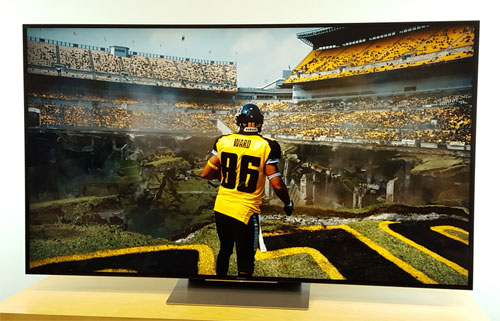
Coming in 2 screen sizes of 55 and 65 inches (model numbers KD-55XD9305 and KD-65XD9305 respectively), the Sony XD9305 features an innovative LED backlight implementation despite not carrying UHD Premium certification from the Ultra HD Alliance (UHDA). Dubbed “Slim Backlight Drive” by the Japanese manufacturer, the new approach involves stacking two columns of two LEDs along the left and right side of the LCD panel, and using separate light guide plates for each LED module to illuminate different zones. According to Sony, this method allows for the best of both worlds: the svelte form factor of an edge-lit LED LCD, and the increased zonal precision of a direct-lit full-array local dimming (FALD) set.
Design
High-end Sony Bravias over the past couple of years had sported a pair of front-firing side speakers which sounded superb but unfortunately increased the bulk of the television considerably. In 2016, the brand has decided to retire these hefty integrated speakers across its entire TV lineup, which will no doubt come as a relief to prospective owners in the UK and Europe who are struggling for space, or those who already have their own dedicated sound system in place.
Sony calls its 2016 Bravia styling ethos “Slice of Life”, referring to how a band of champagne gold accent around the outer frame creates an illusion of two slates being glued together. The fairly reflective, glossy LCD panel is bordered by a suitably slim black bezel.
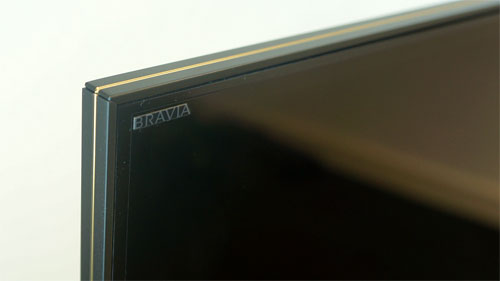
The panel sits on a central rectangular stand with a brushed metallic silver finish. Viewed from the side, the top half of the set is impressively thin, though the bottom half inevitably thickens to accommodate the internal processing and connection inputs. Like more and more Sony TVs these days, the KD65XD9305 comes with an external power brick with detachable cables that are reasonably long to cater for flexible installations.
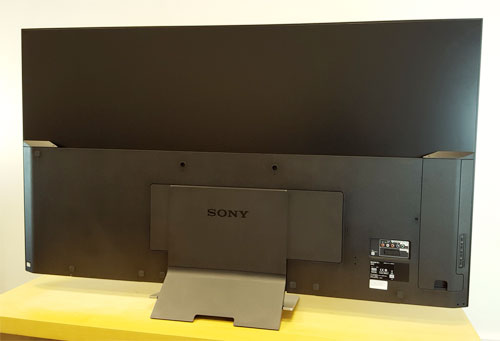
Around the back, Sony has included a cable-organising clip, not to mention cover plates for many of the exposed connection ports to keep things tidy. Whilst acceptable, build quality can come across as a bit plasticky.
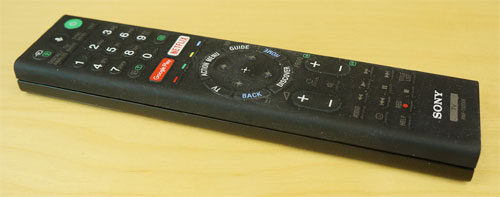
Unlike some other TV makers, Sony has consolidated the remote controls into one unit on the Bravia XD93. Donning some “Slice of Life” cues (note the groove between the back cover and the front), the remote is skinned in textured soft rubber to improve grip. Its minimally-raised faux buttons provide wonderful tactile feedback, but can be frustrating to use especially in the dark – we’ve lost count of the number of times we’d mistakenly pressed the [Action Menu] button instead of the [Up] key.
Connections
All four HDMI inputs passed 3840×2160@60Hz resolution with HDCP 2.2 according to our tests.
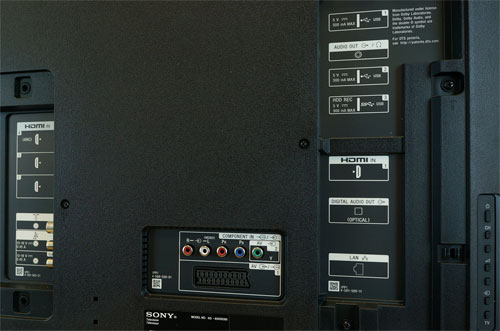
Calibration
We calibrated our Sony KD65XD9305BU review sample in the [Cinema pro] picture preset for regular HD content, and in [HDR video] mode for 4K HDR material (which we’ll elaborate in the “Picture Quality” section later in this article). Equipment used included a profiled Klein K10-A meter, a Murideo Fresco Six-G test pattern generator, and SpectraCal’s CalMAN Ultimate software. As is the case with almost every Sony television we’ve tested, the 65XD9305 delivered outstanding colour accuracy (once greyscale was properly aligned) in spite of the absence of an advanced colour management system (CMS).
Greyscale
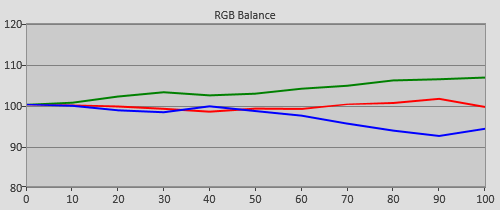 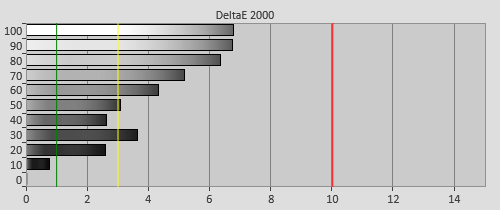 |
| Pre-calibration RGB tracking and delta errors (dEs) |
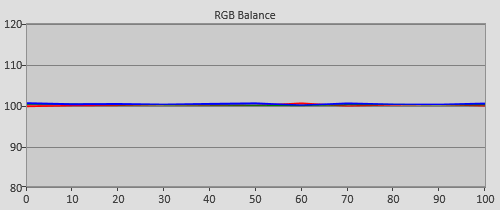 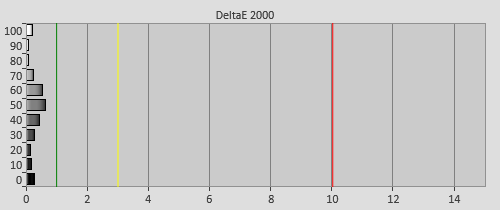 |
| Calibrated RGB tracking and dEs after 2p & 10p white balance adjustments |
Gamma
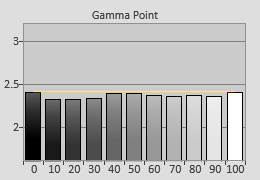 |
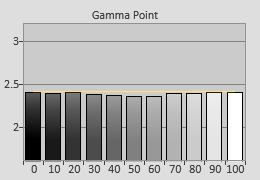 |
| Pre-calibration gamma tracking (2.36) | Post-calibration gamma tracking (2.37) |
Colour
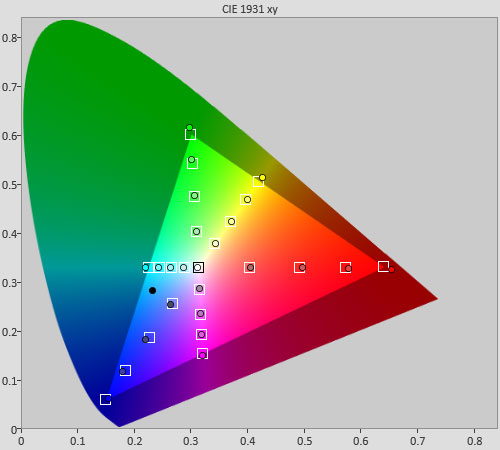 |
| Post-calibration colour saturation tracking |
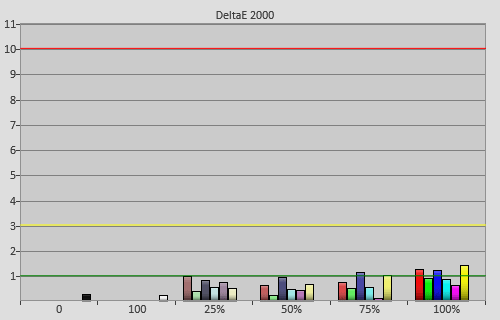 |
| Post-calibration colour errors (<3 not appreciable to the eye) |
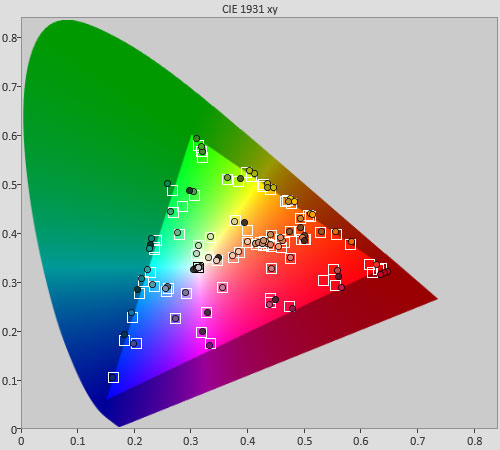 |
| Post-calibration Colour Checker SG test |
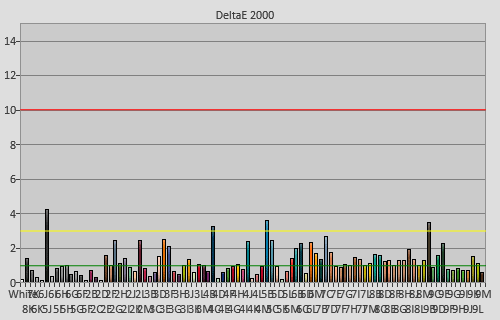 |
| Post-calibration Colour Checker SG errors (<3 not visible to the eye) |
Benchmark Test Results
| Dead pixels | None |
| Screen uniformity | Light bleed from 4 corners; one faint thin vertical band |
| Overscanning on HDMI | 0% if [Screen Format] “Full” & [Display Area] “Full Pixel” or “+1“ |
| Blacker than black | Passed |
| Calibrated black level (black screen) | LEDs dim down/ shut off |
| Calibrated black level (4×4 ANSI) | 0.036 cd/m2 |
| Black level retention | Auto-dimming with full black screen |
| Primary chromaticity | Good |
| Scaling | Very good for HD sources |
| Video mode deinterlacing | Effective jaggies reduction |
| Film mode deinterlacing | Passed 3:2 & 2:2 in SD with [Film Mode] engaged, though cadence lock occasionally lost in HD |
| Viewing angle (cone) | 65° |
| Motion resolution | 1080 with [MotionFlow] “Clear” & “Custom“ |
| Digital noise reduction | Optional; effective when engaged |
| Sharpness | Defeatable edge enhancement |
| Luma/Chroma bandwidth (2D Blu-ray) | Full luma; chroma horizontally blurred except in [Game] & [Graphics] modes |
| 1080p/24 capability | No judder in 2D |
| Measured panel refresh rate | 120Hz |
| Measured peak brightness | 1045 cd/m2 on 2% window |
| Measured DCI-P3 coverage | 95% |
| Input lag (Leo Bodnar tester) | 51ms in [Game] & [Graphics] modes |
| Full 4:4:4 reproduction (PC) | Yes for 3840×2160@60Hz with [HDMI Enhanced Signal] |
Power Consumption
| Default [Standard] mode* | 78 watts |
| Calibrated [Cinema pro] mode | 63 watts |
| [HDR video] mode | 202 watts |
| Standby | <1 watt |
*Note: [Light Sensor] was enabled by default out of the box.
Picture Quality
The Sony KD-65XD9305 uses a 10-bit AMVA LCD panel from AU Optronics (AUO). Native black level (i.e. without the help of local dimming) was deep by LED LCD standards, measuring 0.036 cd/m2 on a 4×4 ANSI chequerboard pattern and full-field black (auto-dimming defeated by displaying a pause icon from our Blu-ray player) once peak white was aligned to our usual target of 120 cd/m2.
| Macro photo of subpixel layout indicating VA-type LCD panel |
As revealed by our thermal scan, the XD93’s LED modules are mounted along both sides of the screen. The company’s new “Slim Backlight Drive” technology indeed resulted in more dimmable zones than what you’d typically expect from an edge LED television. Using our own custom-authored test pattern of a small white box crawling horizontally then vertically against a black backdrop, we counted 4 columns and 8 rows lighting up, giving a total of 32 zones – the highest we have on record for an edge-lit LED LCD to date.
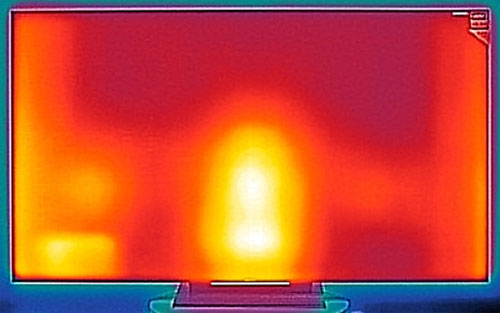
From our testing, every zone was capable of being turned on and off independently of one another, but the dimming algorithm could be a bit hit and miss at times. For example, occasionally in certain dark scenes we would spot a zone that’s far away from the main action area lighting up, even though by common sense it should remain darkened. Nevertheless, on the whole the local dimming system on the Bravia KD65XD9305 was quite effective, and users shouldn’t even think about switching it off.
Three [Auto local dimming] settings are offered besides “Off“, namely “Low“, “Medium” and “High“. Going up the intensity ladder would generally (it’s scene-dependent) darken more zones at the expense of aggravating blooming (a phenomenon where bright objects that are smaller in size than each locally-dimmed zone exhibit circumferential halos against a dark background).
Backlight & Screen Uniformity
With [Auto local dimming] disabled, our Sony KD65XD9305BU review unit exhibited backlight bleed from all 4 corners, which is perhaps unavoidable given the company’s drive for a slimmer design. We found it necessary to set [Auto local dimming] at least to “Medium” before corner bleed was attenuated to an acceptable degree, but even then the lack of homogeneity would rear its ugly head whenever a video frame was bright enough to light up the zones.
Naturally, during brighter scenes this wasn’t a major problem, since our eyes tend to ignore darker portions of the image in the presence of brightness (not to mention the depth, detail, faithful colour reproduction and cinematic quality delivered by the Bravia X93D). However, in low-APL sequences (such as the opening titles and end credits in The Dark Knight) the flashlighting surfaced more frequently than we would’ve liked, although for full disclosure we were watching in a pitch-black room. The introduction of some ambient lighting can mitigate the issue, but placement needs to be chose carefully (ideally behind the display – technically known as bias lighting) due to how reflective the screen is.
Grey uniformity was very good for an edge-lit LED LCD: we ran various shades of grey slides, and witnessed very little dirty screen effect (DSE), though the borders were darker than the centre. There’s a very thin, faint vertical band just off-centre on the left, but it’s only noticeable at high backlight settings (read: HDR) during slow pans across a tonally uniform background.
Motion
Overall, motion performance was slightly improved on the Sony XD9305 compared with last year’s X93C. Judged using the horizontally scrolling lines pattern in Chapter 31 of the FPD Benchmark Software Blu-ray disc, a motion resolution of 1080 lines (or higher) was now attainable with [Motionflow] set to “Clear” or “Custom“. Here’s a detailed breakdown of the various [Motionflow] options:
- “Standard”: Frame interpolation; motion resolution 600 lines; moderate soap opera effect and interpolation artefacts.
- “Smooth”: Frame interpolation; motion resolution 650 lines; more apparent soap opera effect and interpolation artefacts.
- “Clear”: A combination of frame interpolation and backlight scanning; motion resolution 1080 lines; mild soap opera effect and interpolation artefacts; screen becomes dimmer;
Viewing Angle
The Sony XD9305’s horizontal viewing angle was very decent for a VA LCD panel. Luminance fell by half at 32.5° off-axis (thus giving a viewing cone of 65°), whereas the gradual increase in off-angle pink tinting nudged delta errors (dEs) above the perceptible threshold of 3 at 23°.
4K HDR
We’d like to kick off this section with some measurements. With HDR mode engaged by injection of metadata from a Murideo Fresco Six-G signal generator, the Sony X93D’s peak brightness came in at 1045 cd/m2 on a 2% window with greyscale calibrated to D65. Of course, the UHD Alliance’s accreditation process for UHD Premium award uses larger window sizes, and our 65-inch sample only managed to hit a maximum of 875 cd/m2 (the UHD Premium specifications demand 1000 nits for LED LCDs) before tailing off gradually, which may explain why the XD93 is not UHD Premium-certified.
Full-field D65 white measured 440 cd/m2 in HDR mode. In terms of DCI-P3 gamut coverage, the KD-65XD9305 reached 95% (calculated using the same methodology adopted by the UHD Alliance for UHD Premium certification):
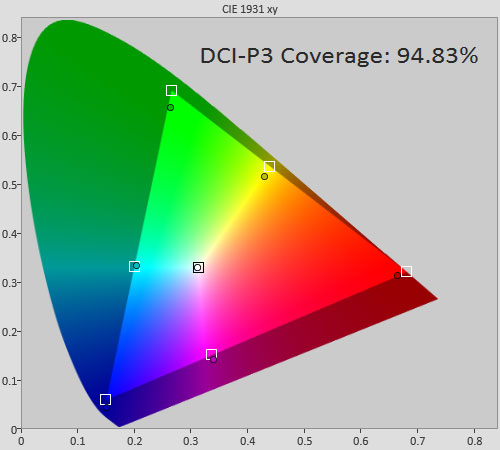
Upon detection of correct ST-2086 metadata, the Sony XD9305 will be locked into its [HDR video] picture preset. There also exists an [HDR Video Vivid] option – curiously buried in the [Reset] submenu – which simply jacks up the dynamic contrast, colour temperature, saturation and edge enhancement, but naturally we refrained from using it given our videophilic predisposition. Whilst not documented, the 4KTV provides several methods (including an unconventional one) to make Ultra HD Blu-ray movies more watchable during the day.
While [Auto local dimming] and [X-tended Dynamic Range] were locked to “Medium” and “High” respectively in [HDR video] mode, we could make changes to most other parameters including [Brightness], [Contrast], [Black Level], [Color temperature] and [Color Space]. Therefore, we proceeded to calibrate the TV for UHD (ultra high-definition) HDR, even though these are early days so several aspects of HDR calibration still need to be ironed out.
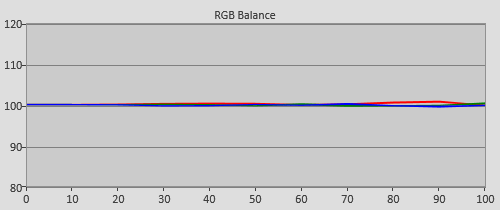 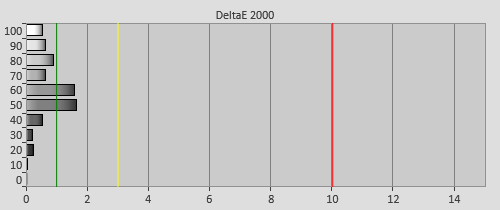 |
| Calibrated RGB tracking and dEs in [HDR video] mode |
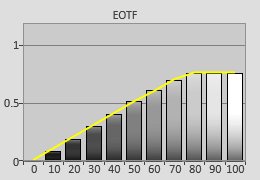 |
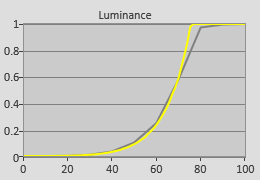 |
| Post-cal perceptual quantizer (PQ) electro-optical transfer function (EOTF) | |
Colour
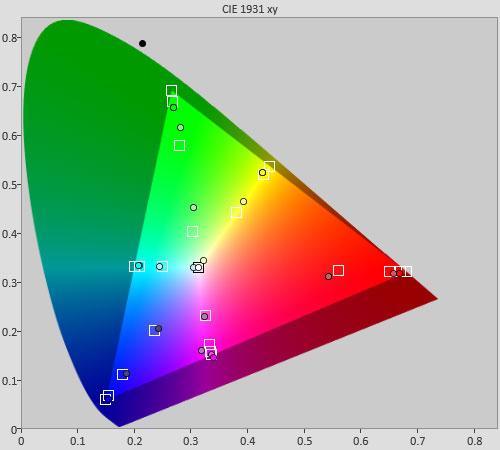 |
| Post-cal sat tracking with [Color space] “DCI” with reference to DCI-P3 |
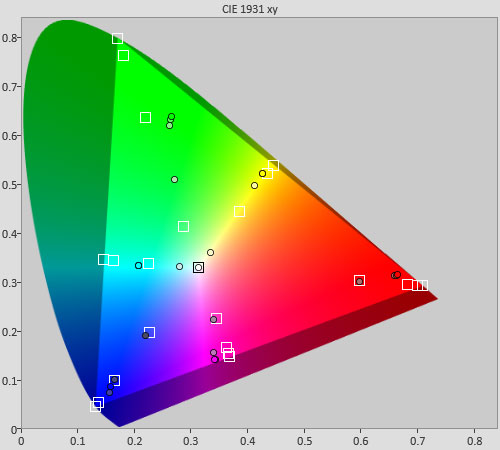 |
| Post-cal sat tracking with [Color space] “BT.2020” with reference to Rec.2020 |
With numbers and graphs out of the way, we hooked up a Samsung UBD-K8500 Ultra HD Blu-ray player to the KD65XD9305, popped in a 4K Blu-ray… and were greeted with a message from the disc spinner suggesting that the display’s not compatible with HDR, so the 65XD9305 was receiving 3840×2160 in standard dynamic range, and stayed in our calibrated [Cinema pro] mode.
It turned out we had to engage [HDMI Enhanced Signal] and then restart the TV to get the Sony XD9305 to recognise HDR metadata from the Samsung 4K BD player. And it was totally worth the effort, because in some ways the KD-65XD9305’s HDR presentation was even more spectacular than the Samsung UE55KS9000 we recently tested despite not boasting as high a peak brightness.
When we reviewed the KS9000, we attributed the very mild judder observed during slow panning shots in The Martian to the 24p frame rate within the source, but once we saw how smooth the same pans were on the KD65XD9305BU, we realised that the Sony was the set that’s actually capable of handling 2160p/24 signal natively without judder.
Dynamism and detail was off the charts, likely helped by good tone mapping of PQ curve. As long as the correct [Color space] and [Live Colour] settings were selected, colours would burst with a dazzling vibrancy, yet all the subtleties would remain intact thanks to the smooth gradation afforded by true 10-bit panel and driving. And as with most high-end Sonys, there’s a magical whiff of cinematic quality that made the Bravia X93D utterly mesmerising to watch.
It goes without saying that such a high [Brightness] setting in HDR mode exacerbated the backlight inconsistency, but truth be told HDR’s intense contrast and colours somehow made the corner bleeds not any more evident than they were in SDR, especially with the judicious use of bias lighting.
We noticed some black smearing of the runners’ silhouettes against the blue sky in The Martian (timecode 2:11:44), which we put down to slower pixel response time. Such instances were few and far between throughout our time spent with the Sony 65XD9305 – we only mention it for the sake of completeness.
3D
The Bravia KD65XD9305 features 3D functionality of the active-shutter glasses (ASG) variety, though no goggles are included with the set. Let’s start with the good news – the 3DTV successfully passed full HD 3D resolution according to our self-authored test pattern. The television could also go sufficiently bright to compensate for the darkening effect of the shuttering lenses, but interestingly the maximum luminance in 3D [Cinema pro] mode was capped to a lower level than some other picture presets.
Now for the bad: the Sony XD93’s tri-dimensional mode appeared to be locked to 60Hz, so 24fps (from 3D Blu-rays) and 50fps material would display with some judder that’s particularly noticeable during slow panning shots. By its own, [Motionflow] had no effect in 3D mode, but together with another picture setting, the judder could be smoothed out, although this would incur unmistakable soap opera effect (which to be fair was less offensive than that generated by many other TV brands) and interpolation artefacts.
Crosstalk was visible at certain depths, which could be ameliorated though not totally eradicated using the [3D depth adjustment] control. This value cannot be saved, so it needs to be tweaked from movie to movie, or even from scene to scene depending on the predominant depth where the crosstalk occurs. In the Tangled night lantern sequence that’s our go-to extra-dimensional test footage, we found a [3D depth adjustment] setting of “1” to be optimal.
Gaming
Placing our Leo Bodnar input lag tester on the middle flashing white box on the screen of the KD-65XD9305, we encountered a weird phenomenon we haven’t seen before. In [Game] and [Graphic] modes, the returned figure would slowly increase from 51ms to 70ms, then quickly drop back to 51ms before repeating the cycle. The same behaviour was observed in all other presets: for example, in [Cinema pro] mode the lag times would yo-yo between 78ms and 94ms.

After ruling out instrument error by obtaining stable readings from three other TVs we had in our test lab, we surmised that the phenomenon might be caused by the stacked LED backlight’s sync rate throwing off the Leo Bodnar device. For now, we’ve jotted down an input lag result of 51ms, which means Sony has gone from a brand that’s the champion of low-lag gaming TVs to one that’s lagging behind in this area.
Video Review
Conclusion
The Sony XD93 is intended as a replacement for both the fateful X90C and the more impressive X93C from 2015. There’s not a single shred of doubt that the KD65XD9305’s image quality is head and shoulders above the X9005C, thanks largely to the use of VA-type LCD panel (which renders significantly deeper blacks) instead of IPS.
Compared with the X9305C though, the situation is less clear-cut. On the plus side, the XD9305’s native black level and motion are slightly better, Android TV is more responsive and stable (we experienced very few occurrences of freezing and no crashes throughout our review period), footprint is smaller, and it holds the current record for the highest number of dimmable zones of any edge-lit LED television. The display also supports HDR10 open-source standard out of the box, with accurate PQ tonemapping (from 4K Blu-ray) and a peak brightness surpassing 1000 nits.
In the Japanese TV maker’s pursuit of ultra-slim aesthetics however, backlight uniformity seemed to have taken a hit: our 65XD9305 review sample suffered from flashlighting from all four corners of the screen, although there’s always a chance that other units in the wild may fare better. Twitch gamers will also be disappointed to learn that input lag has increased by 16ms (i.e. one frame) from last year’s Sony Bravia Ultra HD models.
At the end of the day, the Sony KD-65XD9305 is a 4K HDR stunner: contrast and colours came to life with an intensity that’s never been seen before in home cinemas, with the UHDTV effortlessly nailing the breathtaking detail and nuanced gradations of the new format. The Sony 65XD93 is proof that you don’t really need a UHD Premium-certified display to get a first-rate high dynamic range viewing experience from Ultra HD Blu-rays.

Note: If you’re interested in buying this TV, please support us by considering making your purchase from our advertising partner Simply Electricals – call 01204 201124 for competitive prices and first-rate service.



In your opinion is the Samsung KS9000 a better tv than the Sony XD93 or on par ?
I dont understand your rating system. Your Samsung Bias seems obvious. How can you say on one hand that the Sony produced juder free hdr in stunning detail. It has the most dimmable zones of an led tv that you’ve ever seen and that the led edge lighting shows innervation. Then give the tv HDTV recommended. Whilst giving the Samsung Ks9000 with its single strip of leds and 18 dimmable zone with judder hdr playback Highly recommended?
You realise that after six months of being in display mode in a store Samsungs 9000 had light bless that could be seen a mile away. The owners forums are riddled with it. The single strip of leds accross the bottom will bless just the same and be much more noticeable. Please explain.
Profit Fever you are absolutly right. And tge worst is. The new OLED got the same rating. Not to mention the Panasonic dx900. This system makes absolutly no sense. The elefant in the room however is HDR BLU Ray. No mention of the forced very dim (around 100nits) picture with a 4KHDR Blu Ray Player hooked up to a tv. I’m so eager to see how they will talk themselfs out when general user are going to complain about that issue. And I’m sorry for not living in a always perfectly dim room. So I apologise for asking for more light output to enjoy my 4K Blu Ray in my living room. I’m humbly sorry.
Sony has regressed with the crappy x930d this year. Won’t be long until they abandon home theater equipment and focus on what they do best: PlayStation. Ironically as a PlayStation company, their new TV has bad input lag.
Yes Reality it would be so nice when the Tv market is going to be more dominated by south korea. And yes the overall very good Review text suggest that this is a crappy tv. Only the lower rating against the ks9000 makes absolutly no sense! Tv priducers need to try harder they said on the Review of the OLED Tv by panasonic.Only a highly recommended beside following quote: beside sone issues this is the best consumer tv we EVER tested. There is absolute no need for innovation anymore. The OLEDS eat every lcd or plasma screen in overall quality. It took LG years and billions to make them affordable (55eg9100) and still, because of some issues like near black uniformity seen in 1% of the scenes and then again by 1% of the consumers. There are no words for waching star wars on an OLED. But still they do as if no big revolution happened. No my friend. More people are beginning to realise a curtain bias for samsung. This is getting more and more obvious.
Sony builds a edge tv with 32 dimmable zones. Not awarded.Lg builds an oled not really awarded. Panasonic builded the best lcd so far but you can imagine what will happen. Samsung however ia always highly recommended. You get the idea
Haha “Reality” the ignorence is unreal. Its staring you in the face.
I just find it unsettling that Samsung make a below average Tv which is only saved by its panels native black performance. It cant produce judder free 4k hdr bluray images even though the whole point and sales pitch of theit tvs is about hdr. I had a samsung 9000 from this year and im massively disappointted.took it back to John lewis and put my Sony W905 back.
KS9000 “Highly recommended”
X935D “recommended”
I dont understand!?
I have not seen so according to comments, or both are highly recommended or are recommended!
KS9500: http://www.digitaltrends.com/home-theater/samsung-ks9500-suhd-tv-hands-on/
“holds the current record for the highest number of dimmable zones of any LED television”
In what alternate reality do you live in where 32 zones is the current record? Do you mean any EDGE lit LED TV? As I can believe that, but FALD displays stomp that number into the ground.
@Profit Fever: No bias here. The Samsung has better black uniformity, true black frame insertion and lower input lag, which is why we rate it above the Sony.
@Reallynotnick: Yes, my mistake… I did mean highest for edge LED. Thanks for pointing it out… article corrected.
Warmest regards
Vincent
@Vincent Teoh
Thank for review!
Repeat my favorite questions)))
1. How many peak brightness Motionflow “Clear” mode and “Clearness” min-max?
2. “black level” engaged from [Auto local dimming]?
The Samsung has better black uniformity? http://www.digitaltrends.com/home-theater/samsung-ks9500-suhd-tv-hands-on/
This varies greatly from unit to unit, given the thinness of models!
True black frame insertion?
LED Clear Motion = flicker.
Is useless!
Sony just make a rgb oled and destroy your competition. Because lg oled will still have issues in 5 years time.
Once 4K bluray players are available Hdtvtest should do a side by side comparison in day and night environments to see which 2016 TV performs the best.
BTW I have a 46W905 and a 48JS9000 both lovely but the Samsung trumps the Sony for upscaling contrast and motion clarity.
Its interesting that when Sony wins out on response time it’s hardly mentioned but when Samsung does it it makes it worthy of a higher score.
Please Vincent answer me this. If the whole point in improved brightness and contrast is HDR, and the Sony does HDR Bluray better! Then how can it not be a better tv? No points for innervation of leds?
What about the elephant in the room, none calibrated standard picture settings in a bright daytime viewing environment.
Worse are the invented numbers. In practice input 50ms lag is good enough for consoles. In practice many do not know that they must put their screens in Game Mode / PC and still play smoothly.
If not a professional player FPS / PC 20ms or 50/60 ms does not change anything.
What’s interesting as well is when Sony was dominating the input lag section of the market on small screens and big screens alike it was worth half a point but now Samsung have managed it It’s worth 10 whole points.
Hi, i wanna know the HDR settings you used. Please can you post these. I downloaded life of Pi hdr and it looks crap. Oh and yes i did change the hdmi input to full.
Cheers :}
In the “Post-cal perceptual quantizer (PQ) electro-optical transfer function (EOTF)” graphs:
What nits (and/or digital values) does the x-axis corresponds too?
“100” is 1000 nits or 10000 nits?
Sony 65X930D, Samsung 55KS9500, Panasonic 58DX900: https://www.youtube.com/watch?v=AzVZ5OP0gSQ
65DX900!
@Vincent Teoh Thanks for the review and for keeping the site going after all these years especially as David is no longer regularly reviewing TVs. It’s great to see you guys still around. Are you sure that’s an AUO panel (did you check with i, 5, vol-, power (or whatever it is these days)? The sub pixels look more like Innolux to me, or are at least unusual for AUO.
Also, when will you be looking at Panasonic’s midrange HDR TVs, specifically the DX700/750?
@Loopthrough: Good point, we’ll try to check before sending the TV back.
Warmest regards
Vincent
http://www.whathifi.com/sony/kd-55xd9305/review
Having just read the review on the 55″ version over on hdfever.f Sony won’t be getting my hard earned £2000 cash for this tv with it’s issues of light leakage on all four corners of the screen, clouding issues and blooming issues. One can’t help wondering what, if any, quality controls are applied to TV’s today!
I wish all manufacturers used external power supplies.
This is probably the electronics part that breaks the most often, and not having to open up the TV to deal with it is a definite advantage. Especially with large screen sizes and the super-fragile nature of modern TVs.
Re my earlier comment, it can’t be Innolux as they don’t make 55″ panels, but it doesn’t look like typical AUO, so unless it’s from a new vendor or AUO have changed their sub pixel structure, it must be custom designed for Sony by (presumably) AUO. Remember that as Sony sets are built by Hon Hai, they could be getting custom panels for them.
When you consider all the flaws of the Samsung and the Sony would I be correct in saying that the Panasonic is the best (affordable) TV to buy this year? I’m in the market and the Lg telephone numbers that appear to be what LG call prices are just not going to happen as its a 65″ that I need.
I’ve seen the Panasonic against the 9 series Samsung from 2015 and the difference was absolutely massive. The Samsung looked about 3 years old in comparison. Lots of light leakage and serious blooming and although it showed more detail everything was over processed and looked false. According to avforums they said that if you want a more realistic picture then go and spend 30,000 dollars on a 25″ studio monitor.
I’m pretty certain that with the 5 year warranty on board too that my money is on the DX902. Anyone disagree with that?
Sorry that previous comment on the 30,000 dollars was written about the Panasonic. The way I had written it sounded like it was for the Samsung.
@Dave McArthur
Personal opinion: I was always a Sony man, and don’t get me wrong I like their products, but over the last ten years I’ve found Panasonic to be more consistent (by miles!) than Sony. When Sony get it right, they are awesome, but they have a lot of misses too. Panasonic, on the other hand, seem to be the Honda of TVs. Quietly reliable and dependable with far fewer fluctuations. If I’d bought a good Panasonic from the start I’d probably never even considered Sony for TVs over all these years. So yes, I would wholeheartedly recommend Panasonic for quality and dependability and build quality.
@loopthrough: Checked the Sony service menu, they’ve changed it, no longer lists the panel used. :-(
Warmest regards
Vincent
https://www.youtube.com/watch?v=8u35pNZB6SY
@Alex
You can’t have good motion without flicker! So BFI is not useless. And if you can’t tell the difference betwenn 20ms input lag and 5mms input lag, I feel really sorry for you, cause you clearly suck at video games.
Will you be reviewing the 75″ version – XD94? Based on the specs and the fact that it has FALD, I’m quite interested in seeing how it performs, compared to the XD93 models.
Plus, there seems to be a lack of good 75″ 4K TVs lately, which I find somewhat disturbing / ironic, given the whole 4K resolution push by the industry and the viewing distances required to benefit from 4K.
I bought the Sony XD93 55″ No one told me that it is a German model and will not receive Freesat. There is no standby light. What is the point of the front small LED. The inputs are for Left handers should be on the right hand side like Samsung which I should have bought as they are or were far more user friendly and have first class support. I dislike the complex Sony Menu ,picture is OK .
I have tested the XD93 ks9000 and the dx902. I have tested on normal tv in standard mode. 4k upscale bluray player in various different picture modes. Hdr on light and dark scenes. I have also looked at design cable management wall mounting profile ease of use unique feature etc. After considering all of this it is clear to me which one i would buy. SONY XD93!
G.Bearman
The XD93 has porting in the middle of the back of the tv and on the sides. Why should they be on the right side? The tv does have freesat not sure where you bought yours from? Sure you actually bought it and not just trying to right a bad review.
Dave McArthur
Panasonic are Plasma experts they were there specialty and did very well. Sony are defiantly the led experts. Dx902 looks like a brilliant tv on demo hdr content. But im put off with the motion and lighting system side by side with the XD93 wins hands down.
Lowest price COSTCO XD9305 55″ £1599.98 incl. vat 65″ £2207.98 incl vat
walk into any retail store and watch the demo come to its black screen and sony logo. you will notice tons of blooming. walk over to the ks8000 (ks9000 u.s) and wait till the end. hardly any blooming from brighter white letters on a blacker background. calibrated equipment and numbefs show no bias. i’ll give motion to sony. they are phenominal, but every sony’s poor contrast this year is sad.
*numbers, *phenomenal. Sorry, sorry everyone.
@vincent @loopthrough : Loop, you were correct. The 65″ is an Innolux (which you can verify by looking up the t-con spare part on eBay for example). The 55″ can indeed not be made by Innolux and is actually a Samsung panel …